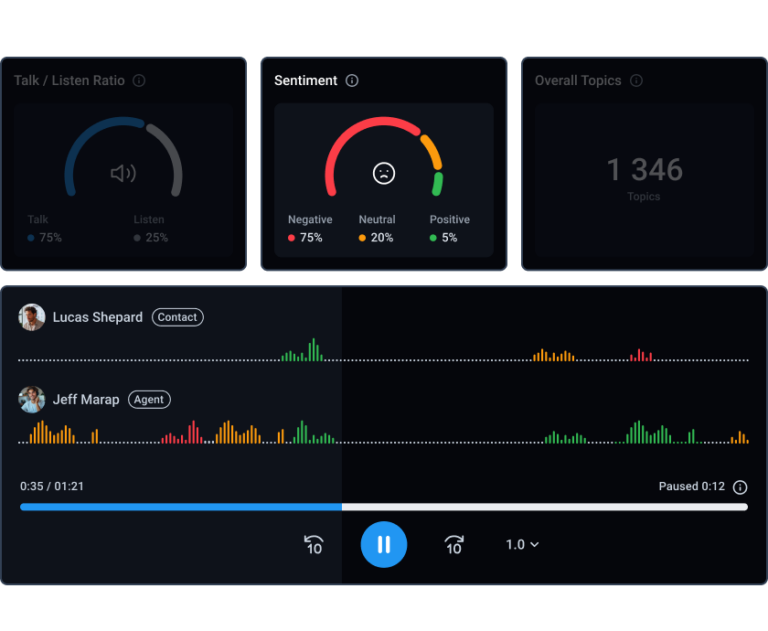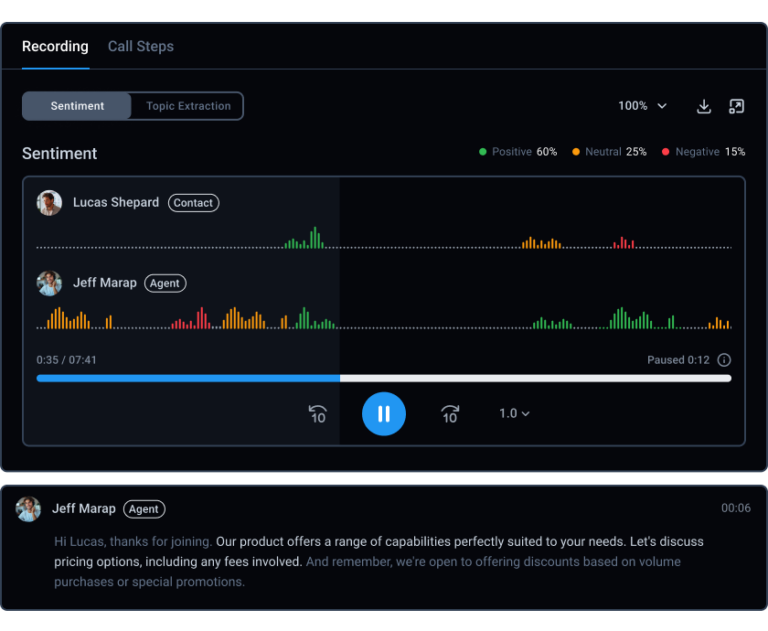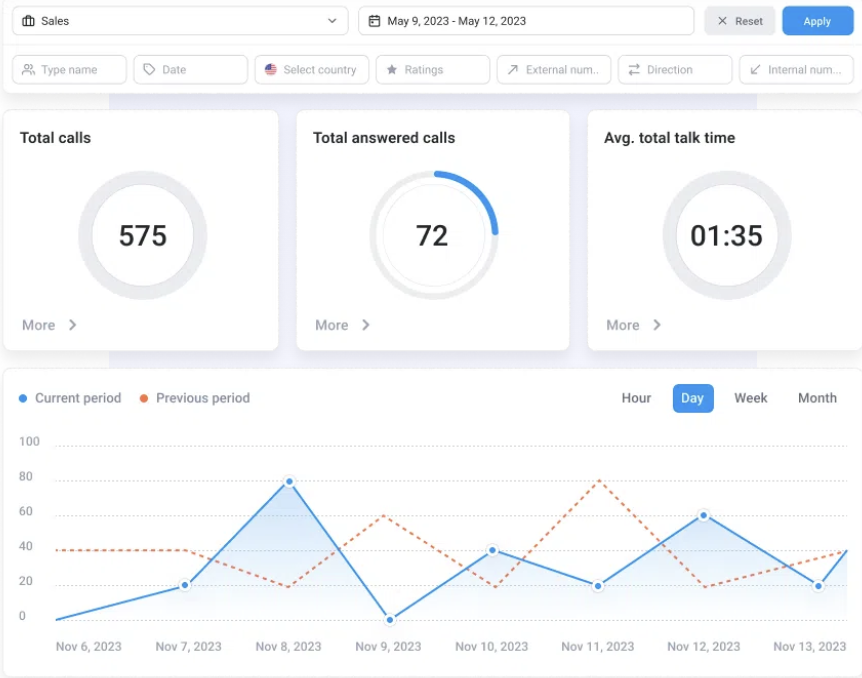Empathy Training for Call Center Agents: Step-By-Step Guide
Great customer experiences hinge on three key elements: success, effort, and emotion. While all three impact loyalty, emotion has the most significant influence*—it’s what drives trust and repeat purchases.
Yet, many teams overlook the importance of emotional engagement in favor of rigid processes and canned responses. Traditional training approaches reduce customer support to a checkbox: memorize these phrases, follow this flow.
This guide changes that. It’s packed with actionable strategies to help your team combine genuine empathy with effective problem-solving—ensuring every interaction leaves customers feeling heard, valued, and confident their issue is resolved.
Ready for real change?
Key Takeaways:
- Empathy can transform your call center. Combine technical knowledge with empathy, to improve first call resolution rates, build customer loyalty, and improve CSAT scores.
- Transform empathy from an abstract concept into a measurable metric through systematic assessment, targeted training, and continuous coaching.
- CloudTalk’s suite of features—from Sentiment Analysis to Intelligent Caller Routing—supports your agents in delivering empathetic service at scale, turning every interaction into an opportunity for brand loyalty.
Build customer loyalty with CloudTalk
Why Empathy Matters for Call Center Agents
A HBR survey found that 72% of executives “understand what it feels like to be one of [their own] customers.” However, only 35% of consumers surveyed agree that companies understand them well.
The disconnect between perception and reality in customer service is stark. It represents more than just misalignment: It’s a critical business vulnerability in today’s experience-driven market. In fact, poor customer service ranks as the second most common reason customers abandon a brand.
Where customer lifetime value drives business sustainability, this statistic should command every executive’s attention.
The solution lies in a capability that’s often overlooked: Empathy in customer service interactions. Nearly 49% of consumers specifically seek empathetic service agents. This isn’t surprising when you consider every customer interaction has a practical need and an emotional component.
Pro Tip
💡Consider this: A customer calls about a service disruption that’s affecting their business operations. The agent has two possible approaches. They can either focus solely on logging the technical issue, or they can acknowledge the customer’s perspective while working toward a solution. The second approach, grounded in empathy, doesn’t just solve the immediate problem. It also builds trust and strengthens the customer relationship.
Research by the SQM Group demonstrates that for every 1% improvement in first-call resolution, there’s a corresponding 1% increase in customer satisfaction. This correlation exists because empathetic agents better understand the full scope of customer needs, leading to more comprehensive solutions in the first interaction.
Harvard’s research emphasized this by showing how customer loyalty isn’t built on delight, it’s built on reducing customer effort. Empathetic agents naturally reduce this effort by:
- Understanding and addressing underlying concerns, not just surface-level issues
- Anticipating related questions or problems before they arise
- Providing clearer, more contextual explanations
How to Boost Empathy For Customer-Facing Teams
Building on our understanding of why empathy matters, the most meaningful customer interactions blend technological efficiency with human understanding.
While AI excels at processing queries and providing quick solutions, it’s the human ability to empathize that turns routine interactions into lasting relationships.
The future of customer service lies not in choosing between AI and human agents, but in leveraging both to create experiences that are both efficient and emotionally intelligent.
Here’s how:
1. Assess Current Empathy Levels of Agents
Many contact center leaders struggle with a critical question: “How do we really know if our agents are showing empathy?”
Traditional quality assurance metrics often miss the emotional nuances that make or break customer relationships, while manual call reviews are time-consuming and inherently subjective. This challenge becomes even more pressing as customer expectations for personalized service continue to rise.
A comprehensive assessment approach combines multiple tools and techniques:
- Customer satisfaction surveys that specifically measure emotional connection
- Performance metrics tracking first-call resolution and customer effort scores
- Quality monitoring scorecards that include empathy-specific criteria
- Post-interaction customer feedback focusing on how “understood” they felt
Modern call center platforms enhance these traditional methods with AI-powered analytics that can assess sentiment in real time. CloudTalk, for instance, offers Sentiment Analysis to evaluate voice tone and language patterns during calls, while the Call Monitoring features enable managers to observe, coach, and participate in conversations as needed. Combined with customizable Analytics Dashboards, teams can easily track first-call resolution and performance.

2. Encourage Active Listening and Emotional Intelligence
Every call center has high-performing agents – the agents that customers experience positive emotions after speaking to. But can you exactly pinpoint the secret to their success?
Let’s start from the crux of the problem. Customers often reach out to support teams carrying a mix of biases and emotions — from hopeful to frustrated or even angry. The difference between a customer who stays loyal and one who leaves often comes down to whether they felt truly heard and understood during their interaction. In fact, 90% of customers will stay loyal after a good experience with an empathetic customer service rep (hello, customer retention).
What sets exceptional agents apart is their emotional intelligence – the ability to understand, interpret, and respond to these emotional signals effectively.
This emotional intelligence manifests through active listening, which goes beyond simply hearing words. It requires agents to:
- Pay full attention to voice tone and speech patterns
- Notice shifts in emotional state during the conversation
- Acknowledge and validate customer feelings before moving to solutions
- Confirm understanding by summarizing key points
Modern tools can help reinforce these skills. CloudTalk features like Sentiment Analysis provide real-time feedback on customer emotions, while Talk/Listen Ratio tracking helps agents maintain the right balance of speaking and listening. AI Smart Notes and Call Transcription allow agents to focus fully on the conversation instead of note-taking, enabling deeper emotional engagement.

This combination of human empathy and technological support ensures agents can deliver what customers need most: to feel heard, understood, and valued.
2. Set Up Empathy Training for Agents
Transform empathy from an abstract concept into a concrete skill through structured training programs. Start by analyzing successful interactions to identify specific phrases and approaches that demonstrate genuine understanding. Use these insights to create practical training scenarios and role-playing exercises.
Some of the customer service training ideas include:
- Analysis of recorded calls to showcase best practices
- Scenario-based exercises dealing with common emotional triggers
- De-escalation techniques for challenging situations
- Team workshops to share successful approaches
Call center platforms can support this development through real-time coaching features. For example, CloudTalk’s Call Recording feature lets you establish best practices from top-performing agents with concrete examples of effective emotional intelligence in action. Plus, Call Monitoring allows supervisors to guide agents during live calls, helping them adjust their approach based on customer emotions.
Additionally, you could create personal development plans based on sentiment analysis trends and schedule regular one-on-one coaching sessions to discuss progress.
4. Train Agents to Manage Difficult Customers
Every challenging customer interaction presents both a risk and an opportunity. When customers reach out in distress, their vulnerability requires an extra level of care and understanding. Success in these moments often determines whether a customer becomes a loyal advocate or leaves permanently.
Key strategies for managing difficult conversations include:
- Recognizing early signs of customer distress
- Maintaining composure while acknowledging emotions
- Using calming language and measured responses
- Finding appropriate solutions without escalating tension
Agents need support during these challenges—which can be provided by modern call center technology like CloudTalk.
CloudTalk’s Intelligent Caller Routing matches customers with agents based on agent expertise with specific issues and real-time availability. The Preferred Agent feature takes personalization a step further by connecting customers with agents they already know and trust. Both these features ensure agents maintain empathy while working toward resolution.
Check out this video for 7 tips to handle angry customers and irate customer calls:
5. Measure Agent Performance
Traditional support metrics tell only part of the story. While operational efficiency matters, emotional connection drives lasting customer loyalty. The key is measuring both quantitative and qualitative aspects of customer interactions.
Core empathy indicators include:
- CSAT scores reveal how customers felt about their experience
- NPS ratings show a willingness to recommend based on emotional connection
- FCR rates indicate whether customers felt fully understood
- Average handle times compared to resolution quality to measure efficiency vs effectiveness
- Positive sentiment trends across interactions
CloudTalk’s Analytics bring these metrics together in meaningful ways:
- Track sentiment patterns across different types of interactions
- Monitor resolution times alongside customer satisfaction
- Identify conversation topics to anticipate your customers’ needs and problems
- Identify top performers and pinpoint areas for improvement to provide focused training
Real-time analytics help supervisors spot opportunities for coaching, while historical trends guide long-term training focus.

Just 9% of Call Center Agents Believe Empathy is Their Greatest Strength*
When customers feel understood, everyone wins. In an environment where customers often feel like just another ticket in the queue, genuine human understanding becomes your most powerful differentiator. It transforms frustrated callers into loyal advocates, turns routine interactions into opportunities for connection, and gives your agents more fulfilling work.
But building a culture of empathy isn’t just about training, it’s about giving your agents the right support. When you combine human understanding with AI-powered tools, you build a call center with empathy at the center of the experience—and encourage agents to revamp their skills.
Technology handles the complexity, freeing your agents to focus on what they do best: Creating genuine human connections that turn customers into advocates.
With CloudTalk and its suite of features like Sentiment Analysis, Call Monitoring, and Call Recording, you can improve your CSAT, NPS and first call resolution rates—while inspiring more empathy in your agents.
Experience AI-powered productivity with CloudTalk
Sources:
Frequently asked questions about empathy training for call center agents
What’s the difference between empathy vs sympathy in a call center?
Sympathy is feeling sorry for customers, while empathy is understanding their perspective. Empathy creates connection through shared understanding, while sympathy just acknowledges distress.
What are examples of chat support empathy statements?
Examples of chat support empathy statements include:
“I understand why this is frustrating, let’s fix it together.”
“I can see why this is urgent for your business.”
“You’re right, this isn’t acceptable. Let’s get it sorted right away.”
What are some empathy exercises for teams?
Some empathy exercises include: role-playing customer scenarios, practicing active listening through call recordings, and analyzing real interactions in team workshops to identify effective empathy moments.






















